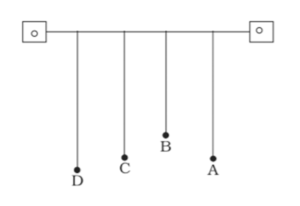
a) D will vibrate with maximum amplitude
b) C will vibrate with maximum amplitude
c) B will vibrate with maximum amplitude
d) all four will oscillate with equal amplitude
Answer:
The correct option b) C will vibrate with maximum amplitude
Explanation:
When a pendulum vibrates in a transverse direction, we have the time period defined as:

A and C’s pendulum lengths are equal to l. The disruption that occurs in the elastic rigid support of time period T. All pendulums B, C, and D are transmitted through support, but the frequency or time is not. Because C has the same period as A, a periodic force of period T causes resonance in C and C to have the same maximum as in resonance.
